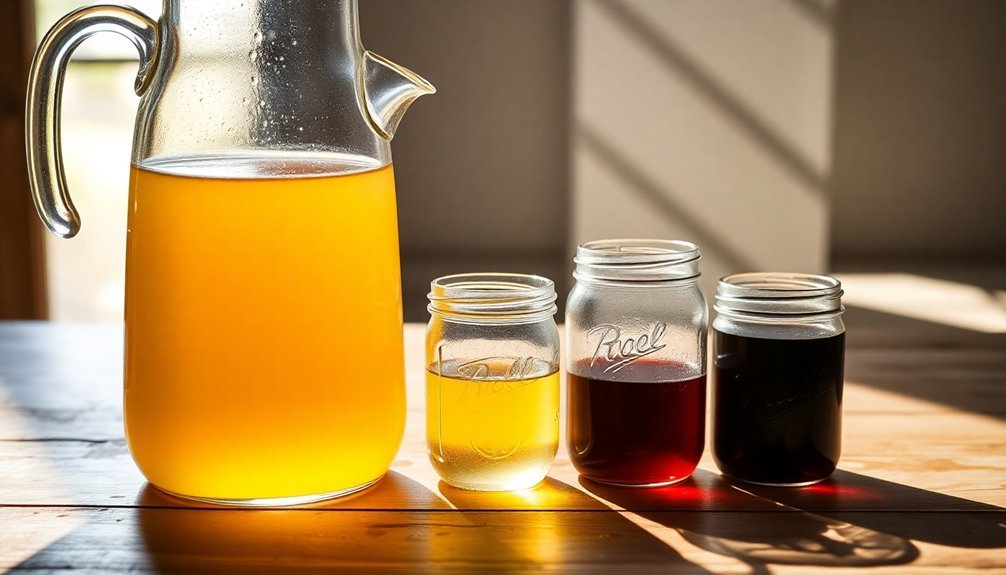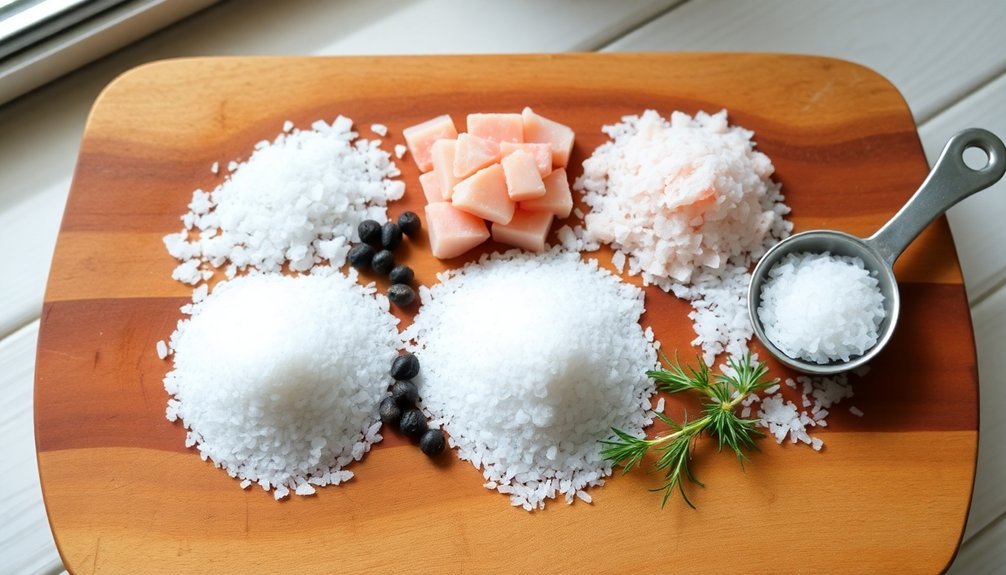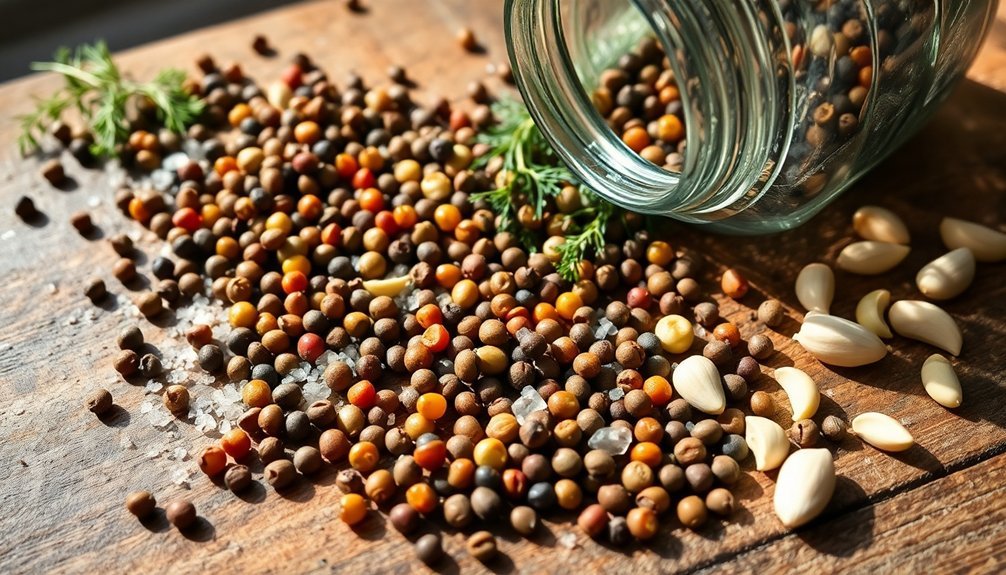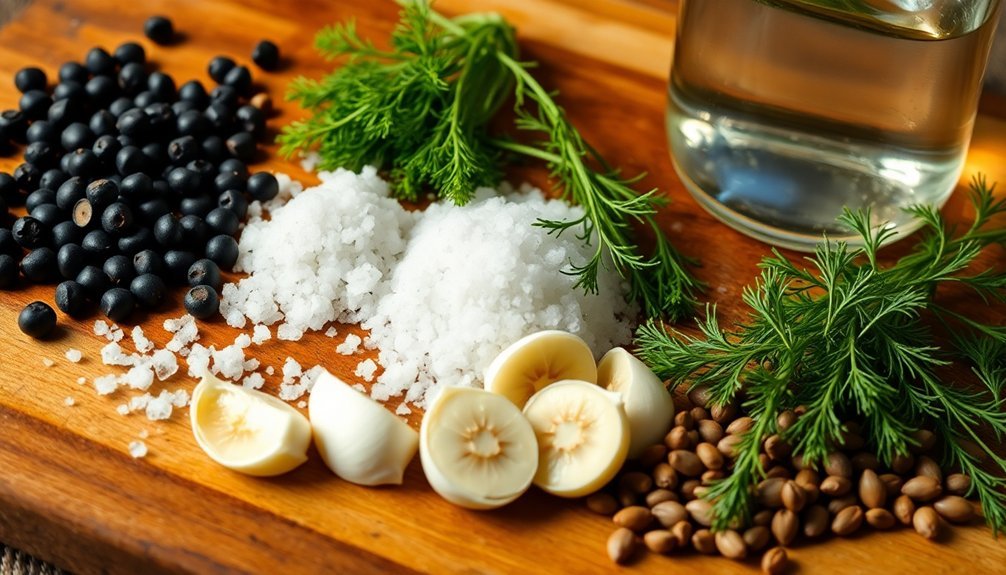A perfect vegetable brine starts with five essential ingredients you can easily find in your kitchen. Begin with distilled white vinegar (5% acidity) or apple cider vinegar for a milder taste. Add filtered or spring water in a 1:1 ratio with your vinegar. Mix in pure pickling salt or sea salt at 2-3% concentration, depending on your vegetables. Include a natural sweetener like honey or brown sugar (1 tablespoon per cup of vinegar) to balance the acidity. Finally, add classic whole spices such as mustard seeds, peppercorns, or fresh dill. These fundamentals set the stage for countless flavor variations and combinations.
The Base Vinegar Selection

The base vinegar serves as the foundation of your pickling brine, making its selection essential for successful vegetable preservation.
You'll want to verify your chosen vinegar has at least 5% acidity to maintain safety and effectiveness in the pickling process.
Maintaining a 1:1 ratio of vinegar to water is crucial for preventing harmful bacteria growth.
Distilled white vinegar is your most versatile option, offering a clean, crisp flavor that won't overpower your vegetables' natural taste.
If you're seeking a milder profile, apple cider vinegar provides a gentler approach with its slightly sweet undertones.
White wine and red wine vinegars are excellent alternatives that add subtle complexity to your pickled vegetables.
While rice vinegar can work, you'll need to confirm it meets the 5% acidity requirement.
You should avoid certain vinegars that can overwhelm your pickled vegetables.
Balsamic vinegar's intense sweetness and dark color will greatly alter your final product.
Similarly, malt vinegar's strong flavor requires dilution with white vinegar if you choose to use it.
It's best to skip aged or concentrated vinegars altogether, as their powerful flavors can dominate your preserved vegetables rather than complement them.
Water Quality Matters
Just as your vinegar selection impacts fermentation success, water quality plays a fundamental role in creating effective pickling brine. You'll want to avoid tap water, as its chlorine content can kill beneficial lactobacillus bacteria essential for fermentation. Instead, opt for filtered, spring, or distilled water to guarantee superior results. Maintaining a 2 to 5 percent salt ratio in your brine solution will ensure proper fermentation.
| Water Type | Effect on Fermentation |
|---|---|
| Filtered Water | Promotes healthy bacterial growth |
| Spring Water | Maintains natural mineral balance |
| Tap Water | Kills beneficial bacteria |
| Distilled Water | Provides pure fermentation base |
Temperature matters too – use room temperature water to dissolve salt evenly throughout your brine. Hot water can harm beneficial bacteria, while cold water slows down the fermentation process. The purer your water source, the more consistent and predictable your fermentation results will be.
Remember that impurities can lead to off-flavors and compromised fermentation. By using high-quality water, you're creating an ideal anaerobic environment that supports the growth of beneficial microorganisms. This attention to water quality not only affects the immediate fermentation process but also influences the long-term shelf stability and nutritional value of your fermented vegetables.
Salt Types and Ratios

Selecting proper salt and maintaining precise ratios forms the backbone of successful vegetable fermentation. You'll want to choose pure salts without additives or iodine, as these can interfere with the fermentation process. Sea salt and pink Himalayan salt are excellent choices, while pickling salt works perfectly due to its clean composition. The salt actively creates a natural brine by drawing moisture from the vegetables through osmosis.
For most vegetables, you'll need a 2% salt solution, though some produce requires different concentrations. Calculate this by weighing your ingredients and water, then multiply the total weight by your target percentage. For a 1L jar, you'll need 20g of salt to achieve a 2% brine.
- Softer vegetables ferment well at 2% salt concentration
- Cucumbers and peppers need 3-4% salt to maintain crispness
- Use 1-3 tablespoons of salt per quart of water as a quick measure
- Olives require a higher 10% salt concentration
- Lower salt percentages speed up fermentation but may sacrifice texture
Remember that salt concentration directly affects your final product's texture and preservation. While too little salt can lead to mushy vegetables, too much can halt fermentation entirely.
The sweet spot typically lies between 2-3% for ideal flavor and preservation.
Balancing With Natural Sweeteners
While proper salt ratios set the foundation for fermentation, incorporating natural sweeteners can transform your brine from good to exceptional.
You'll find that natural sweeteners not only balance the acidity but also enhance the overall flavor profile of your pickled vegetables.
For a basic starting point, use 1 tablespoon of sweetener per cup of vinegar and 2 teaspoons of salt. You can choose from several natural options: honey adds depth and complexity, agave nectar offers sweetness without excess calories, and monk fruit sweetener works well for low-carb preferences.
Brown sugar brings a rich, malty note that's particularly appealing in certain brines.
When adding sweeteners, remember that they'll interact with your other ingredients. They work particularly well with spices like garlic and mustard seeds, while also helping to balance citrus juices if you're using them instead of vinegar.
Be careful not to add too much sweetener, as this can soften your vegetables and compromise their crunch.
Make sure you're dissolving your sweeteners completely by bringing the brine to a boil, then let your pickled vegetables marinate in the refrigerator for at least 24 hours to develop their full flavor.
Essential Spices and Aromatics

The art of pickling comes alive through the careful selection of spices and aromatics, which form the heart of any great brine recipe. You'll want to start with essential whole spices like mustard seeds, coriander, peppercorns, fennel, and cumin as your foundation. These spices release their flavors gradually, infusing your brine with complex layers of taste.
For an enhanced flavor profile, you'll need to incorporate fresh aromatics. Here's what you should consider adding to your brine:
- Sliced onions provide a sharp, savory base note
- Fresh garlic cloves add pungent depth
- Grated ginger brings warmth and zesty undertones
- Fresh turmeric root contributes earthy complexity
- Grated horseradish delivers spicy heat
You can experiment with additional whole spices like anise seeds, juniper berries, or whole cloves to create unique flavor combinations.
Fresh herbs such as dill, parsley, and cilantro complement these spices beautifully, adding brightness to your brine.
Remember to crush whole spices slightly before adding them to release their essential oils, maximizing their flavor contribution to your pickling liquid.
Frequently Asked Questions
How Long Do Brined Vegetables Stay Fresh in the Refrigerator?
You'll find your brined vegetables will stay fresh for 2-3 months in the refrigerator. For the best flavor and texture, you should eat them within a few weeks of making them.
Can I Reuse the Leftover Brine for a New Batch?
Yes, you can reuse leftover brine for new ferments! Add 1/2 cup to a quart jar or 1 cup for a gallon container. It'll act as a starter culture, but make sure it's free from cloudiness or mold.
Why Did My Brined Vegetables Turn Mushy?
Your vegetables may have turned mushy due to over-fermentation, insufficient salt in your brine, improper submersion under the liquid, or incorrect temperature. It's important you monitor these factors during fermentation.
Should Vegetables Be Hot or Cold When Adding Them to Brine?
You'll want your vegetables at room temperature before adding them to brine. If you've blanched them, make sure they're completely cooled in an ice bath to maintain their desired texture and crunch.
Can I Process Brined Vegetables in a Water Bath for Longer Storage?
Yes, you can safely process brined vegetables in a water bath for longer storage, but you'll need to follow tested recipes and guarantee your brine has adequate acidity (5% vinegar) for food safety.
In Summary
You've got all the essentials to create perfect vegetable brines every time. Remember to combine quality vinegar with filtered water, use the right salt-to-water ratio, and balance the flavors with natural sweeteners. Don't forget those aromatic spices that'll give your pickled vegetables their signature kick. With these five simple ingredients mastered, you'll be creating crisp, flavorful pickled vegetables that'll impress family and friends.





Leave a Reply